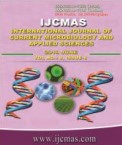


 National Academy of Agricultural Sciences (NAAS)
National Academy of Agricultural Sciences (NAAS)

|
PRINT ISSN : 2319-7692
Online ISSN : 2319-7706 Issues : 12 per year Publisher : Excellent Publishers Email : editorijcmas@gmail.com / submit@ijcmas.com Editor-in-chief: Dr.M.Prakash Index Copernicus ICV 2018: 95.39 NAAS RATING 2020: 5.38 |
The aim of this study was to determine the antioxidant and antibacterial property of Nelumbo nucifers (lotus) leaf extract. Total phenolic content and DPPH (2,2-diphenyl-1-picrylhydrozyl) scavenging methods were used to evaluate the antioxidant property of crude extract. DPPH scavenging capacity of extract varied significantly (p<0.05) depending on the concentration, except 5.5mg/ml and 7 mg/ml concentrations. The maximum concentration (10mg/ml) of the extract showed the highest scavenging effect (57.75%), whereas the lowest concentration (0.5mg/ml) of the extract showed the least scavenging capacity (9.30 %). The phenolic contents exhibited a similar trend to that of DPPH. Total phenolic compounds increased with the increasing concentration of Nelumbo nucifera leaf extract. Disc diffusion and broth micro-dilution methods showed bactericidal property of lotus leaf extract. Water, acetone-water and ethanol-water based extracts were tested against selected gram-positive (Staphylococcus aureus) and gram-negative (Aeromonas hydrophila, Pseudomonas fluorescens) fish bacterial pathogens. The broth micro-dilution method with TTC (2,3,5-triphenyl tetrazolium chloride) to indicate the viability of aerobic bacteria was found to be the best alternative method.
 |
 |
 |
 |
 |